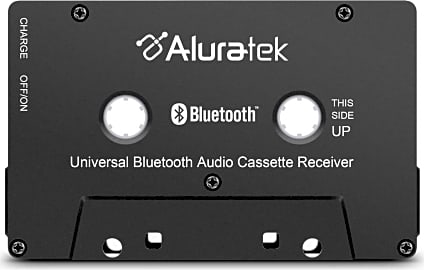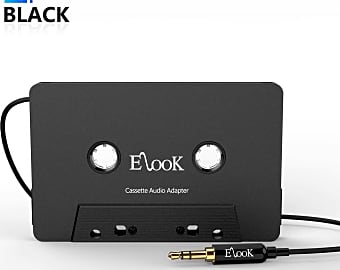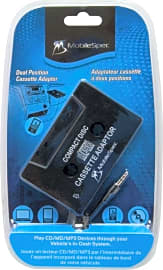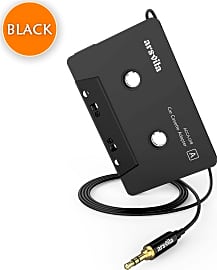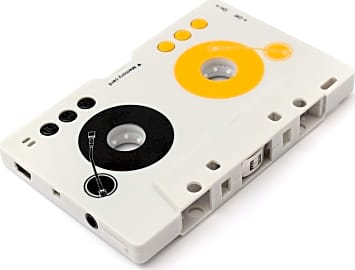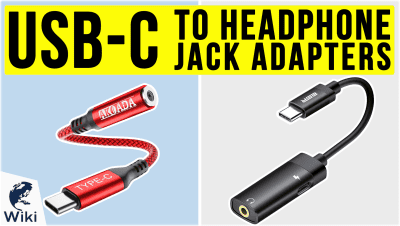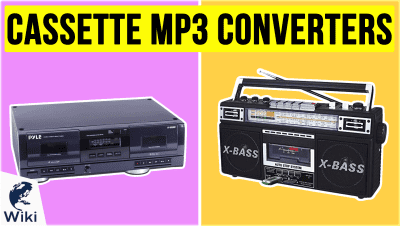The 8 Best Cassette Player Adapters

This wiki has been updated 34 times since it was first published in October of 2016. If you love your old car but wish you could listen to all your current favorite tunes or streaming services, then one of these cassette player adapters is just what you need. Simply slot one into your car's tape deck and connect it to any device with a 3.5-millimeter jack. If your smartphone doesn't have a headphones port, there are some Bluetooth-capable options available, too. When users buy our independently chosen editorial selections, we may earn commissions to help fund the Wiki.
Editor's Notes
June 21, 2020:
It seems like people generally expect a lot with these adapters, and many that are fine often get reported for quality-related issues. While there are certainly models that don’t do the best job of reproducing audio, I must point out that the quality of sound you get with these models has as much to do with your phone or audio device as it has to do with the actual cassette, a fact which I guarantee that many people will attest to after having tried their adapters with different types of phones.
With that being said, I’ve removed a few of the models that I felt were genuinely struggling with quality-related issues. Most of the issues with adapters are related to audio reproduction quality or to the level of mechanical ‘whirring’ noise that is a byproduct of all the moving parts of the cassette. However, there are a few issues related to the flimsiness of the cord, durability of other parts of the adapter, or ease-of-use, etc.
Corded Cassette Adapters: most will have a 1/8-inch (3.5-mm) headphone jack that you find standard on a number of MP3 players, laptops, phones and other devices, though, if your smartphone or audio device uses the USB-C jack, you can always get a USB-C to 3.5-mm adapter.
Here I’ve made a couple of replacements, taking out the Showtime Aux 880 and Sony CPA9C. The latter was so overpriced for what it was offering that I initially thought it was a Bluetooth-equipped model. In their places, I've added better models, like the Reshow Audio and Arsvita ACCA. I’ve also replaced the Insten Car Cassette with the Elook Audio. The primary selling point of the Insten is that it produces next to no mechanical noise, and the Elook does the same, but you’ll probably find that the Elook also offers better durability and audio quality.
It appears that there currently aren’t a ton of exceptional cassette player adapters on the market, so I’ve resolved to shortening the list in order to highlight only the better options and removing models like the ReTrak ETCASSETTEB which had a flimsy retractable cord, as well as the Everydaysource Adapter.
Cordless Cassette Adapters work on Bluetooth functionality and are naturally a little more expensive. We had two options in the previous list that were cordless – the iTape Car Bluetooth and the Ion Audio Bluetooth, and I’ve kept the iTape, but replaced the Ion with the Aluratek Bluetooth.
While the iTape and Ion both have Bluetooth, they also have built-in microphones so they can include hands-free phone calling functionality into their design. The Aluratek unfortunately doesn’t have this feature, but what it lacks with superfluous add-ons, it more than makes up for in quality, and it significantly improves upon the battery life and charging speed of its predecessor. I’ve also left in the FunnyToday365 Retro Car Telecontrol, which is an interesting option, and offers something unique in the way of cassette player adapters. However, as an MP3 player, it’s quite rudimentary, and I’ve moved it down the list because of its lack of smart-device compatibility and proper interface among other features.
In some respects, you may be better off just plugging a smartphone or more sophisticated MP3 player into a cordless adapter with Bluetooth, which is where I’d personally put my money, but I wanted to leave an array of options on the table here.
The Origins Of Car Audio
Goldmark showed it to Chrysler, they bought the idea, and then messed it up, badly.
Everybody loves a good jam. In fact, it's somewhat of a tragedy that there are no recordings of some of the greatest collaborations in history, when the likes of Bach, Beethoven, and Mozart were found hammering away on pianos well into the night, competing in musical improvisation battles in front of increasingly inebriated pub-dwellers. Unfortunately, it wasn't until 1877 that none other than absurdly prolific inventor Thomas Alva Edison would record "Mary Had a Little Lamb" and play it back on the phonograph. To be fair, Edison's first recordings were rather low-fidelity, and captured only a very narrow frequency band, but he had done it. Alexander Graham Bell and Charles Tainter expanded on the gramophone, developing the wax cylinder phonograph, becoming the first duo ever to put it on wax, an achievement that still inspires hip-hop artists to this day.
Soon after, the phonograph became the Victrola, and the field of home entertainment was born, in all of its lo-fi, monaural glory. While gramophones were large, heavy, and generally immobile, the 1930s saw the Galvin brothers attempt to transplant the spirit of the Victrola into the body of the newly popular motorcar. This endeavor resulted in the Motorola, the first widely available portable radio, and the beginning of car audio.
Let it be known that people tried to put record players in cars. The vinyl LP's developers created an entirely new record format, with hair-width microgrooves, and though they were the size of 45-RPM singles, the new records held as much music as an LP. In fact, the system sounded great, and the inventor Peter Goldmark used precise tuning to coax it into skip-free performance.
CBS didn't want it because it wouldn't prominently feature their advertisers. Goldmark showed it to Chrysler, they bought the idea, and then messed it up, badly. Where Dr. Goldmark had taken great care to tune the device perfectly to prevent skipping, the automaker had no such intentions, and shipped hordes of terribly performing turntables across the country. A majority of them failed, the new format fell by the wayside, and another respectable, yet doomed entertainment engineering project went down in the history books.
Say It With Tape
Vinyl records and broadcast radio had at least one thing in common: they both used magnetic tape at some point during their production. Advertisers distributed jingles and other spots on spools of tape that could play repeatedly without rewinding or reversing, while the very analog data that made up records' grooves was sourced directly from magnetic recordings. So, it was basically destiny when the Stereo-Pak become the first popular magnetic playback device in North American automobiles. Its popularity didn't last, as it was soon overtaken by William Lear and friends' legendary 8-Track system, the first wildly popular cartridge system, which saw an immediate flood of new artists and albums.
It was this foresight that opened the doors to both car and home, cementing the 8-Track's place in the annals of American audio.
Lear also took an important professional step that still escapes many modern engineers: he gathered the heads within the industry and developed a consistent, official standard. It was this foresight that opened the doors to both car and home, cementing the 8-Track's place in the annals of American audio. But they weren't perfect; the sound wasn't the best, they had a tendency to jam, and they were barely functional as recordable media. It was time for a change, and one was afoot — courtesy of a medium that no one had ever intended to use for entertainment purposes.
Belgium-based Philips Corporation patented the compact cassette in 1962, piggybacking off the overarching concept of the traditional reel-to-reel player. Dr. Goldmark, star-crossed inventor of the infamous car phonograph, then contributed an even smaller form-factor tape, which the Philips team turned into a two-sided, 40- to 60-minute-long storage device that they knew for certain would change the world, when it came to voice dictation in business offices.
Everybody loves a good dictation, right?
Luckily, engineers got the idea pretty quickly, and installed casette players in many of the fanciest luxury cars, beginning in the late 1960s. By the mid-1970s, the compact cassette had transformed into legitimate hi-fi entertainment, and was standard equipment on most vehicles.
Captain, Auxiliary Systems Are Go
One of the hallmarks of the 21st century is the innovative creation, storage, and playback of digital music. And even though somewhat predatory, fruit-based technology corporations do threaten it from time to time, the 3.5-millimeter stereo plug is ubiquitous among desktops, laptops, smartphones, and all multimedia devices. While almost everybody has a headphone jack, quite a lot of people don't have car stereos with Bluetooth capability or even an auxiliary plug. For that matter, some don't even have CD players, and that's exactly why the cassette player adapter was initially created.
One of the hallmarks of the 21st century is the innovative creation, storage, and playback of digital music.
In a sense, these adapters are simply taking the actual cassette tape out of the equation. The head units inside them operate just like the one in a tape recorder, except instead of laying down magnetic charge on a tape, it transmits a signal directly to the pickup in the tape deck. The end result is a surprisingly true sound, because the actual tape and oxide coating that cause many of a cassette's deficiencies are nowhere to be found.
There's not a ton of variation between models, though some are definitely more reliable than others. Make sure to select one that you can orient properly in your tape deck; depending on where the wire leaves the case, and whether it can be moved, some adapters will have trouble fitting into tighter slots. There's also a design that doubles as a standalone music player; just pop it in the tape deck, and play away, no cords needed. No matter which you choose, one of these adapters can greatly expand almost any older vehicle's music catalog, and it won't cost you very much, either.


